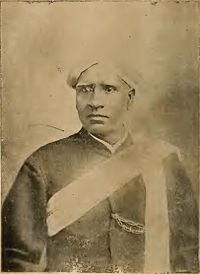Sir Kumarapuram Seshadri Iyer | |
|---|---|
 | |
| 15th Dewan of Mysore | |
| In office 12 February 1883 – 18 March 1901 | |
| Monarchs | Chamaraja Wodeyar, Krishna Raja Wadiyar IV |
| Preceded by | C. V. Rungacharlu |
| Succeeded by | T. R. A. Thumboo Chetty |
| Personal details | |
| Born | 1 June 1845 Palghat, Present day Kerala |
| Died | 13 September 1901 (aged 56) Mysore, Kingdom of Mysore |
| Spouse | Dharmasamvardhini (1865-1901) |
| Alma mater | Presidency College, Chennai |
| Profession | Civil servant, administrator |
Sir Kumarapuram Seshadri Iyer (also spelled Aiyar) (1 June 1845 – 13 September 1901), was an Indian advocate who served as the 15th Dewan of Mysore from 1883 to 1901. He was the second longest serving dewan of Mysore after Purnaiah. He is regarded by most as the maker of Modern Bangalore.
Seshadri Iyer was born in a Kerala Iyer family from Palakkad in the Malabar district of Madras Presidency (modern day Kerala). He had his early education in Calicut and graduated in arts from Presidency College, Chennai, in 1868. He was also a qualified lawyer.
Seshadri Iyer joined the services of the Mysore kingdom in 1868 and served as a district magistrate and later as Personal Secretary to the Dewan, Rungacharlu before being appointed Dewan himself. Seshadri Iyer was the longest serving Dewan of Mysore kingdom and served from 1883 to 1901.
He started the Mysore Civil Service Examinations which were held for the first time in 1891 and the Department of Geology and the Department of Agriculture were founded in 1894 and 1898. Other notable achievements include the construction of the Vanivilas Sagar dam across Vedavati river, the initiation of the Shivanasamudra hydroelectric project in 1899 (the first such major attempt in India), electricity and drinking water (the latter through pipes) being supplied to Bangalore and the founding of the Archaeological Survey of Mysore (1890) and the Oriental Manuscripts Library.
Seshadri Iyer established the Kolar gold fields and Victoria Hospital and commissioned the Shivanasamudra hydel-electric power project. Seshadri Iyer had to deal with a devastating plague which afflicted Bangalore in 1898 and was responsible for the decongestion of streets and reconstructing the city in the aftermath of the plague.